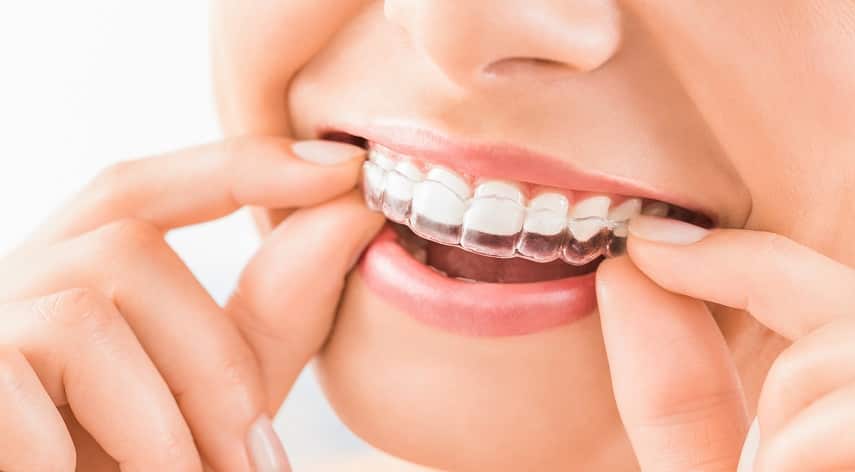Teeth Straightening Methods

Are you interested in straightening your teeth? If you have a mouth full of wrongly-aligned teeth, you might be wondering where to start when it comes to teeth straightening methods.
The good news is that there are plenty of things you can do to help your teeth become neater and more positioned while improving your smile and appearance.
Continue reading as we take a look at the various ways that you can begin the teeth straightening process. Let’s begin!
Table of Contents
ToggleTraditional Braces
Traditional braces use small brackets attached to each tooth with a particular type of glue. These brackets are then connected by a wire, which puts gentle pressure on the teeth and helps move them into their correct positions over time.
They can be made from different materials, such as metal, ceramic, or plastic. Metal braces are the most noticeable but are also the most durable and effective. Ceramic and plastic braces are less noticeable but may not be as effective as metal braces.
Braces can be worn for anywhere between 6 months to 2 years, depending on the severity of the misalignment. During this time, the patient must attend regular appointments with their orthodontist. They will monitor the treatment progress with each visit to have the braces adjusted.
The adjustments are made by tightening or loosening the wire or changing the size of the rubber bands that hold the wire in place. It can sometimes be uncomfortable and cause soreness. But, it’s vital not to miss an appointment with your dentist and follow their instructions.
It’s also important to maintain good oral hygiene while wearing one. Once the dentist removes the braces, the patient may need to wear a retainer for a certain amount of time. This will help prevent the teeth from going back to their original positions.
Lingual Braces
Lingual braces are attached to the back of the teeth instead of the front. This makes them an excellent option for people who want to straighten their teeth but don’t want the braces to be visible.
The brackets and wires used in lingual braces are placed on the tongue-facing side of the teeth. This means that they are virtually invisible when the patient smiles or speaks.
Like traditional braces, lingual braces apply gentle pressure to the teeth, shifting them into the correct positions over time. However, because the brackets and wires are placed on the back of the teeth, the treatment may take longer than traditional braces.
Lingual braces can be a bit more expensive. They can also be a little uncomfortable at first and difficult to clean because they are attached to the back of the teeth and may cause irritation to the tongue.
However, most patients get used to the feeling after a few days or weeks. Despite its disadvantages, the benefits of an invisible orthodontic treatment can be well worth it for some patients.
Self-Ligating Braces
Self-ligating braces are an orthodontic treatment that uses a specialized bracket system to straighten teeth. Unlike traditional braces that use elastics or metal ties to hold the wire in place, self-ligating braces use a unique clip to hold the wire in place. This means the braces require fewer adjustments and can move the teeth more efficiently.
One of the main advantages of self-ligating braces is that they must need fewer adjustments than traditional braces, which can reduce the total number of crucial appointments. This also means the braces may be more comfortable than traditional ones since they apply less pressure to the teeth.
They may be more expensive than other braces because they need special training and installation equipment. So, self-ligating braces can be an excellent option for people who want a more efficient and comfortable way to straighten their teeth.
This treatment may be more costly and require extra care to keep clean. But, many people find the benefits of more efficient and more comfortable orthodontic treatment well worth it.
Invisalign
Invisalign straightens crooked or misaligned teeth using a series of clear, removable aligners. The aligners are almost invisible and can be removed when eating, brushing, and flossing.
Unlike traditional braces, Invisalign does not use brackets or wires. Instead, the aligners work by applying gentle pressure to the teeth.
They gradually shift them into their correct positions over time. The aligners are replaced every two weeks, and each new set differs from the previous ones.
Invisalign is generally more expensive than traditional braces. But many people find it more convenient and comfortable. The treatment takes six months to one year, depending on the severity of the misalignment.
To get started with Invisalign, the patient must consult an orthodontist trained in the Invisalign system. The orthodontist will take x-rays and photographs.
They will use these to create a 3D model of the patient’s mouth. This model is used to create a customized treatment plan and to design the aligners.
One of the biggest advantages of Invisalign is that the aligners are almost invisible. They are a popular choice for people who are self-conscious about wearing braces. They are also more comfortable than traditional braces since they do not have brackets or wires that can irritate the mouth.
However, wearing the aligners at the recommended time each day is vital to ensure effective treatment. Each option has its advantages and disadvantages, depending on the individual case. That’s why it’s crucial to schedule an orthodontic consultation here to receive a proper diagnosis and determine which method is best for you.
Which Teeth Straightening Treatment Is Best for You?
Teeth straightening has come a long way with countless methods available today. So, it is best to discuss with your dentist which approach would be most suitable for you.
You can surely get the sparkling, straight smile you are looking for with the right treatment. There’s no time to waste! Make an appointment today and get started with your journey.
Do you want to find more helpful info? Check out more of our guides on our blog today!
Pankaj Majumder, a seasoned Civil Engineer, combines technical expertise with a passion for innovative infrastructure solutions. With a strong academic background and diverse project experience, he excels in creating sustainable and resilient structures that shape the future of urban development.
Recommended For You
Spread the loveSexual health is an essential aspect of personal well-being. If you’re based in London and need STI testing,
Spread the loveIn today’s fast-paced world, managing your health effectively is more important than ever – especially for those of
Spread the loveThe EGFR blood test is an important way to check how well the kidneys are working. It checks



